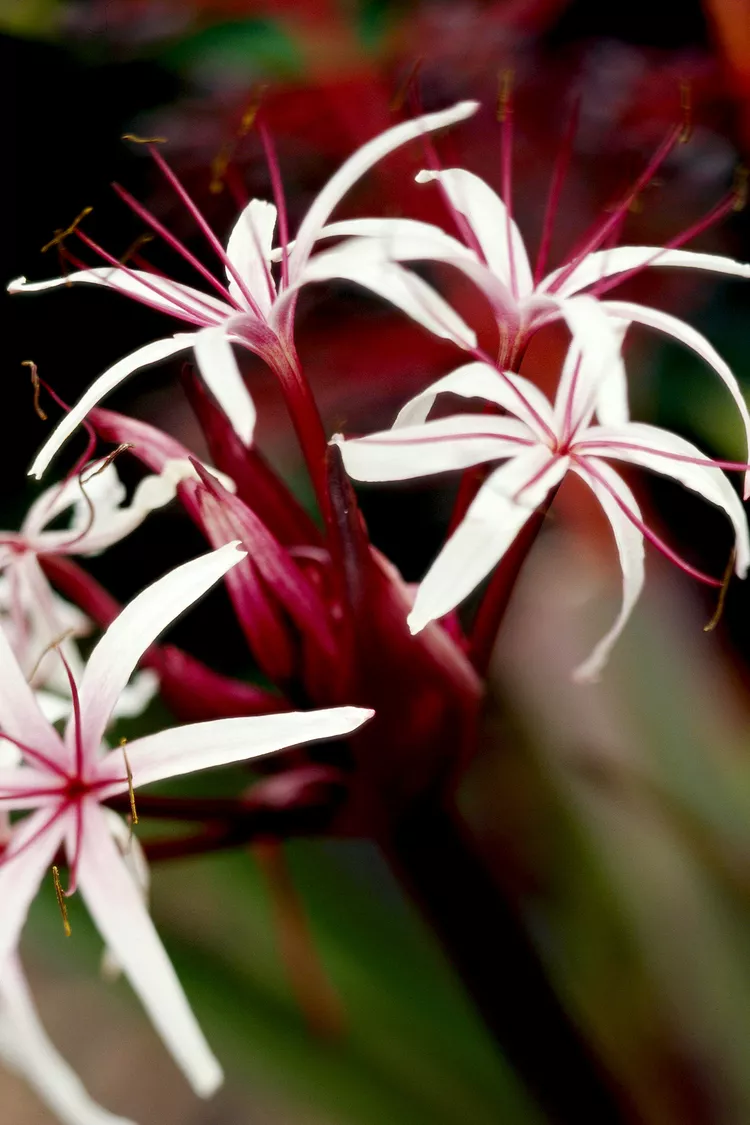How to Plant and Grow Crinum Lily

Crinum lilies have graced Southern gardens for many years. In cold climates, crinum lilies shine in pots on a patio during summer but must be overwintered inside. Whether grown in-ground or in a pot, the plants send out fragrant spidery flowers in shades of white, pink, and red in early summer. Flower stalks emerge above 2- to 5-foot-tall arching straplike green leaves. Sometimes plants grow a second flower stalk in late summer.
This plant is sometimes hard to find in local nurseries, so check online sources and perennial providers for varieties in a host of colors.
All parts of crinum lily are toxic to humans. Plant them away from areas where children play.
Crinum Lily Overview
| Genus Name | Crinum |
| Common Name | Crinum Lily |
| Plant Type | Bulb |
| Light | Part Sun, Shade, Sun |
| Height | 1 to 6 feet |
| Width | 2 to 7 feet |
| Flower Color | Pink, Red, White |
| Season Features | Colorful Fall Foliage, Fall Bloom, Spring Bloom, Summer Bloom, Winter Bloom, Winter Interest |
| Special Features | Attracts Birds, Cut Flowers, Fragrance, Good for Containers, Low Maintenance |
| Zones | 10, 11, 8, 9 |
| Propagation | Division |
| Problem Solvers | Deer Resistant, Drought Tolerant |
Where to Plant Crinum Lilies
Crinum lilies grow best in part shade but tolerate any amount of light. They are equally at home in dry, sandy soil and in moist soil at the edge of a pond, although moist soil is where they bloom best. Potted plants need a large container filled with good-quality potting soil.
How and When to Plant Crinum Lilies
Although these tropical bulbs can be planted year-round, April through October is the best planting time. Avoid fall and winter to prevent cold damage. Choose a sunny or part sun location in well-draining soil and some shelter from the wind. Dig a hole for each bulb that is about 10 inches deep. Bury the largest part of the bulb underground, up to the place where the stem emerges from the neck or growing point. The neck should be positioned at soil level and the stem or growing point just above the soil surface.
In areas where crinum lilies aren't hardy, plant them in containers that can be brought inside for the winter. Choose a heavy ceramic or terra-cotta container with drainage holes and fill it with good-quality potting soil. As when planting outdoors, bury most of the bulb, leaving only the stem or growing point above soil level.
Crinum Lily Care Tips
Crinum lilies thrive for decades with little care as long as their basic requirements are met.
Light
Although they tolerate most light conditions, crinum lilies grow best in partial shade. When grown in full sun, they appreciate shade in the afternoon.
Soil and Water
During the warm growing season, keep the well-draining soil moist. During the rest of the year, it can be drier. Crinum lilies are sometimes found growing in the moist soil around ponds, but they tolerate dry, sandy soil just as well. They are drought-resistant.
Temperature and Humidity
Crinum lily bulbs are hardy to 25°F, but they prefer the warmer weather in zones 8-11. When grown in pots in colder zones, they should be moved to a sheltered area or indoors for the winter. Gardeners don't need to concern themselves with humidity for this plant unless they live in extremely hot, dry areas.
Fertilizer
Crinum lilies don't require fertilizer to grow, but they produce more flowers when they receive a slow-release, balanced fertilizer in early spring. For crinums in containers, an application of half-strength liquid fertilizer monthly during the blooming season works well. In either case, follow the directions on the product label.
Pruning
Pinch off the flowers when they fade. Trimming any dead or damaged leaves is about all the pruning the crinum lily needs. After the blooming season is over, snip off the stem at its base.
Potting and Repotting Crinum Lily
The best container size for a crinum lily is at least 2 inches larger in diameter than the bulb, but it needs to be at least 14 to 18 inches deep. Fill it with good-quality potting soil and bury the bulb up to the stem or growing point. Keep the soil moist, not wet, during the time it grows outdoors. In winter, move the container inside to a sheltered area. When you see the foliage of the plant wilt frequently, it is time to repot it in a larger container.
Pests and Problems
These huge leafy plants emerge from gigantic pest-resistant bulbs and are rarely bothered by deer and rodents. However, their leaves tend to attract grasshoppers. Pick them off and drop them in a container of soapy water. Also, be on the lookout for mealybugs.
How to Propagate Crinum Lily
Crinum lily bulbs produce pups that can be separated from the parent plant. However, crinum lily doesn't like to have its roots disturbed, so only divide them when necessary. In early autumn, while the plant is not actively blooming, use a sharp spade to dig a wide circle about 2 feet around an established crinum lily. Gently lift the entire plant from the ground. Break apart or cut sections that contain one or more pups and immediately replant the sections in a prepared area of the garden. Do not let them dry out. Return the parent plant to the ground.
Types of Crinum Lily
Crinum asiaticum
Crinum asiaticum bears clusters of spidery white flowers top a large central stem. The large, dark green leaves may reach 3 feet long on a plant that grows 5 feet tall or more. Zones 8-11
Southern Swamp Lily
Crinum americanum offers white spider-like petals that droop from a central stem. This Southeastern native does best in moist soil and blooms in late summer. The plant grows 2 feet tall. Zones 9-11